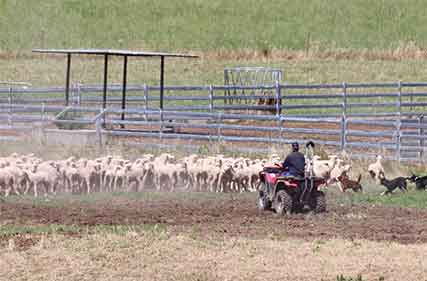
Wool demand and production have plateaued in the last four years and Merino wool tracking finer. Image Kim Woods
Wool producers need to be ready to optimise marketing strategies and pivot production within the context of the land’s capability to surf the volatility wave of the next 20 years.
Forward market and hedging officer Grant Hutchins, Fox & Lillie Rural, analyses the cycles and trends in wool and prime lamb markets, and outlined the national sheep profile over the next two decades at the Pasture Agronomy Service conference at Wagga Wagga on July 2.
Mr Hutchins said the national clip is getting finer, the lamb carcases are getting heavier (not necessarily more slaughtered), crossbred wool production has declined, and merino wool production has plateaued after a steep decline.
Fine Merino wool production has been trending upwards and 28 micron wool production from crossbred sheep going down over the last 20 years.
“Composite production has risen but it is relatively small. Wool of 25-28 micron has slumped from 2004 as crossbred production declined,” Mr Hutchins said.
“Strong price incentives from 2016 resulted in flock rebuilding in the Merinos. For the last 10 years we have seen the national flock oscillate between 64 and 74 million head. Within that time frame, we have seen a big variability in production by micron.
“This indicates to me there is some optimism in the Merino sector, which has done a good job of catching the opportunities of a dual-purpose operation. The Merino sheep has the benefit of producing a commodity that can be stored while crossbred wool production is largely considered a by-product.”
Mr Hutchins focuses on the Italian market for ultra and super fine wool into markets which differentiate themselves from fast fashion houses.
He said long term prices for Merinos continued to face the challenges of fast fashion, competition from cotton and synthetic fibres, and a retail apparel sector chasing dollars per square foot of real estate.
“We are really struggling to get access to that floor space. I despair as this beautiful commodity we create suffers this competitive disadvantage because of its inherent cost to produce and deliver to the consumer, who would rather put on a polyester fleece than a comfortable woolly jumper.
“But we seem to have found a baseline – we have wool exports for the last several years in the 300,000 to 340,000 tonnes and that’s encouraging.”
A slump in crossbred wool prices has been attributable to the collapse of the Chinese home property sector and lack of demand for home furnishings and carpet production.
“With the downs wool, the Chinese consumer has been enlightened to the benefit of wool quilts, feeding into demand for the coarser end of the wool market. This is providing a base in prices for crossbred wool more recently,” Mr Hutchins said.
“In the last four years we have seen a plateauing in wool demand and production, with merino wool tracking finer and I expect that to continue. The crossbred sector is not going to overtake the merino sector and we could be not dissimilar to where we are now in 20 years’ time.
“One thing is certain – boom/bust cycles will continue, and with it your profitability volatility. Be ready to optimise marketing strategies and pivot production within the context of your land’s capability and hopefully master surfing the volatility wave we will be facing over the next 20 years.
“When you see the next $20/kg wool, especially if your production costs are modest and you are making a good margin, make use of forward sales or sell a portion to optimise your marketing alternatives to protect revenue.
“The drivers are wool price, meat price, production costs and marketing outcomes. Switching the mentality to what can I do best for my farm for my area will allow you to carry on producing the best product and being in the best shape to manage the volatility and variability in weather and growing conditions while continuing to bring that commodity to market.”
-Kim Woods
